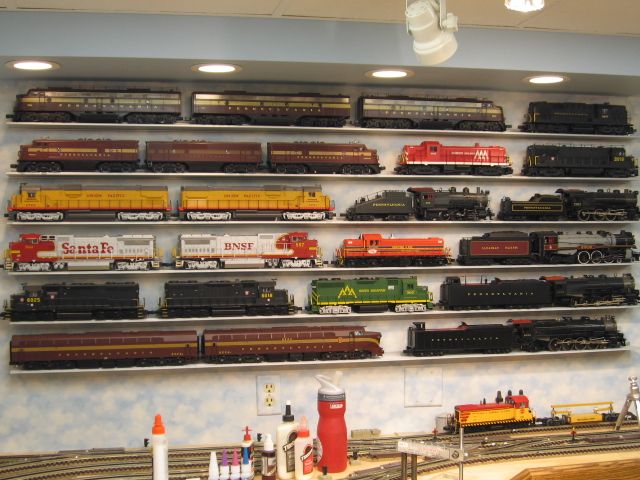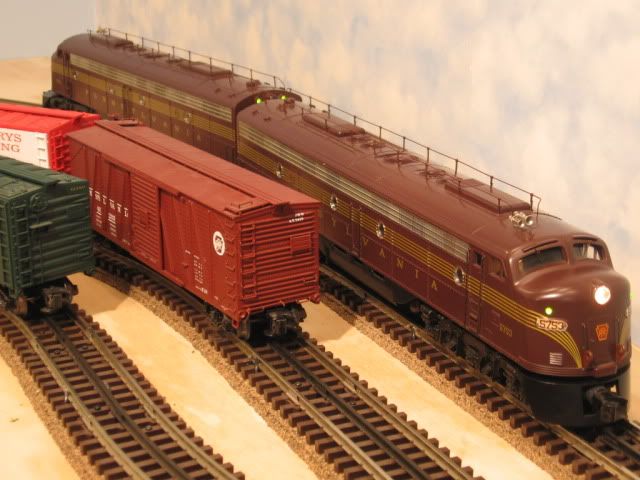With the PRR Tuscan Sharknose what did the Pennsy traditionally pull with these engines. Also if you have some pictures of this engine and its consist, would like to see whats on your RR
THANKS
Steve
|




|
With the PRR Tuscan Sharknose what did the Pennsy traditionally pull with these engines. Also if you have some pictures of this engine and its consist, would like to see whats on your RR
THANKS
Steve
Replies sorted oldest to newest
The Pennsy had both versions of the sharknose, the BF16 freight with 4-wheel trucks and the BP20 passenger with 6-wheel trucks. The Tuscan would normally indicate passenger service. The BP20's ended up on the New York and Long Branch in New Jersey doing commuter train service but they were probably used on a variety of passenger services before that.
Tuscan sharknoses on the PRR were class BP20, only modeled in 3-rail by Weaver in brass. These are big units (longer than an E8) and ride on 6-wheel trucks. They pulled premium passenger trains early in their careers but spent most of their time on secondary passenger runs, sometimes pulled by only a single A-unit.
There are a lot of O-gauge freight sharknoses (about the size of an F3) with 4-wheel trucks out there that are painted tuscan red. They are all fantasy. All of the real PRR freight sharks were the standard DGLE (dark green locomotive enamel) in color.
Nice summary Bob. I think the freight sharks at least at first also had a unique large Keystone on the sides centered on the strips. And the freight sharks initially had 5 stripe paint schemes.
This topic has come up before. Basically, the Tuscan painted freight Sharks simulate the much longer Passenger sharks for those with layouts with tight radius curves and shorter 16" passenger cars. The Weaver BP20 Passenger Sharks need O-72 curves. If you don't have that size of curve (or larger) and want to run a passenger train led by Sharks, you need a Tuscan freight shark. Freight Sharks look best with 16" cars.
Here is a photo of my scale Passenger Shark next to a scale freight Shark.
@CAPPilot posted:
Wow... talk about learning something every day on the forum!!! I had no idea that there were two versions of the shark. Absolutely love the long passenger version. Great shot, Ron.
Paul,
Thanks. The Weaver engine is great with nice detail, and the AB set is really impressive compared to most everything else on the layout. But they were not the best runners straight from Weaver. Mine had the old TAS boards replaced with ERR boards and they run a lot better.
@CAPPilot posted:Paul,
Thanks. The Weaver engine is great with nice detail, and the AB set is really impressive compared to most everything else on the layout. But they were not the best runners straight from Weaver. Mine had the old TAS boards replaced with ERR boards and they run a lot better.
It almost looks like a Centipede!!!
@CAPPilot posted:This topic has come up before. Basically, the Tuscan painted freight Sharks simulate the much longer Passenger sharks for those with layouts with tight radius curves and shorter 16" passenger cars. The Weaver BP20 Passenger Sharks need O-72 curves. If you don't have that size of curve (or larger) and want to run a passenger train led by Sharks, you need a Tuscan freight shark. Freight Sharks look best with 16" cars.
Here is a photo of my scale Passenger Shark next to a scale freight Shark.
That's a lot of shark.
The BP20s were massive locomotives built only for the PRR. Delivered in DGLE as Ron shows they pulled Blue-Ribbon trains on the broadway to Chicago, but were sidelined to commuter service on the NY&LB around 1956-1957. The tractions motors were superior to EMD's in many ways, but the internal plumbing of each was almost unique. They lasted on the NY&LB until 1964 when there were enough E7s available in the pool to replace them due to shrinking long distance service. They pulled P70s in a several configurations during their NY&LB stint including the P70R and most famously the P70fbR with it's distinctive porthole window at the restrooms. They received the 5 stripe Tuscan scheme during and after 1952 and got the single stripe scheme during shop repairs starting in 1955.
I don't believe the RF-15s lasted long in service as the Pennsy settled on the F7 and GP9 models for most freight service around 1953. However, the Pennsy ran the wheels off any locomotive they owned so you can be sure the Baldwins turned plenty of miles before going to scrap.
The Weaver model retailed for $800. Try to find one now at all. Good luck. They tend to go for much, much more. It is the only NY&LB PRR diesel I do not own. Wish like many I had purchased one when they came out.
When I get some free time, I'll photograph my PSC P70R and Alco Models P70fbR. Both are two rail brass models. The fbR version came courtesy of this forum's very own Ed Rappe who knows what eras I model for the PRR.
Did the real Pennsy ones all have those antenna rails on top ?
Weaver offering, A, non powered B set. There was an upgrade, to powered B unit. There was also available, additional Powered A units. Limited quantities. Pennsy, Long Island RR, ran A B A sets. They did not MU with other units.
The antenna rail was part of a Pennsylvania radio phone communication system, early, before walkie-talkie, or cell phones. My foggy head thinks the Antenna/phone system, on board, talked to the wires, on poles, beside the track. I could be wrong, and often. Mike CT ![]()

A comparison of unit lengths. Top shelf is a Weaver E8 set. BP20 bottom shelf. 
Bowser offered a radio phone kit that could be added to different units.
E8 phone. Brass wire was not part of the kit.

Weaver GE U25b with a Bowser phone kit.

Thanks for the wealth of info here. I have a pair of Lionel Sharknoses on order. as these are 17" in length each they appear to be the "freight" version which suits me fine as I primarily run freight.
:-) Steve
The trainphone system and antennas was installed on most PRR diesels used in Road service. There were probably a few exceptions. Switchers did not get the system, but there were some Alco switchers I have seen photos of that have Trainphone antennas. They were probably used for transfer runs or something similar. I think some of the early road switchers may have come without it. ON the other hand, I think basically all Cowl units, Fs, Es, PAs, FAs, etc, got them.
I have been told that the system did not work in Electrified territory, but I don't know if the source was good.
And surprisingly, since the use of the system was in the transition era, there were some steam locos that had it installed. The antennas were installed on the tender deck.
The Withers books on Pennsy diesels tell you by unit, whether or not they had train phones or other options.
Has anyone seen a GG1 or E44 with Trainphone antennas? The PRR may have been able to send a signal through the overhead wire and pantographs.
Jan
Nope. Like prrjim correctly posted, Trainphone did not work in electrified territory so no electrics had it installed.
L.I.Train - Out of curiosity, what RR did you decide to order?
@CAPPilot posted:
Ron, that's cool. Count me with the other folks that never realized that the much larger passenger version existed. You really do learn something every day here. ![]()
The Trainphone worked by inducing a signal in the loco (or cabin Car) antenna, which was then picked up by the rails and transmitted to the Cabin Car (or loco) antenna. Since the coupling of the signal to and from the rails increases with antenna length, the antennas were as long as possible.... full length of diesel roof, full length of Cabin Car Roof, full length of tender deck.
The 25 Hertz AC current in the catenary completely overwhelmed the trainphone signal, so that is why there was no trainphone in electrified territory, as others have pointed out
Why they didn't just do radio is somewhat of a mystery. I know they say they didn't "own" any frequencies, but I can't imagine that was a major stumbling block for a company the size of PRR to deal with.
@gunrunnerjohn posted:Ron, that's cool. Count me with the other folks that never realized that the much larger passenger version existed. You really do learn something every day here.
John,
Thanks. Only the Pennsy owned them, and only 9 ABA sets at that. You have to be a real Pennsy nut, or saw it in the Weaver catalog, to know about them. Weaver had them in both Tuscan and DGLE; both real hard to find.
I guess I missed on both counts, though I am a PRR fan and do have lots of their stuff. ![]()
@gunrunnerjohn posted:Why they didn't just do radio is somewhat of a mystery. I know they say they didn't "own" any frequencies, but I can't imagine that was a major stumbling block for a company the size of PRR to deal with.
I wager maybe the regulations. Seems that there was a lot going on between the 30's and 40's with the agencies that existed at the time. I looked up Train phone and there was a few links off of that talking about what today is the ITU I think it was. They were the result of two agencies joining.
It could also be that they didn't want anyone "spying" on their operations. I would imagine that alone would be a factor into developing something that is your own to ensure their company is secure from outside interference.
I wish I copied some of the Wikipedia stuff, hard to do on my phone.
This was a part of what it said there, from Wikipedia:
"Between 3 September and 10 December 1932, a joint conference of the International Telegraph Union and the International Radiotelegraph Union convened in order to merge the two organizations into a single entity, the International Telecommunication Union. The Conference decided that the Telegraph Convention of 1875 and the Radiotelegraph Convention of 1927 were to be combined into a single convention, the International Telecommunication Convention, embracing the three fields of telegraphy, telephony and radio.
On 15 November 1947, an agreement between ITU and the newly created United Nations recognized the ITU as the specialized agency for global telecommunications. This agreement entered into force on 1 January 1949, officially making the ITU an organ of the United Nations."
I think it said that the Trainphone started development right around then.
I was about to write what Dave said. I would also add the trainphone worked through long tunnels and around curves.
Access to this requires an OGR Forum Supporting Membership
